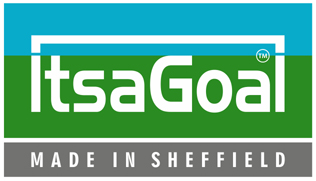PLASTIC FOOTBALL GOAL POST SAFETY STANDARDS
PLASTIC FOOTBALL GOAL POST SAFETY STANDARDS – THE FACTS
As a founder member of the original European football goalpost standards committee, we have been involved in the introduction of goalpost standards and safety from the start. Prior to this, no standards were in force to regulate goalposts in any way. The death of a young lad named Jonathan Smith in 1991 from a heavy steel freestanding goalpost was the catalyst to drive this safety issue to the forefront. At that time the UK only had two main suppliers of goalposts Harrods based in Lowestoft and Edwards Sports based in Bridport. The introduction of safer plastic football goals by our company (ITSA GOAL) completely changed the goal post industry and junior football.
We as a company still campaign to ban all heavy freestanding goalpost as weight is the common factor causing serious injury. The goalpost standards however still to this day allow such goalposts to be made and used. Plastic goals are by far the safest for young children. We have always designed and tested our plastic and alloy football goals to the relevant standards to ensure they are fit for purpose and offer higher safety parameters. Many suppliers are still using BS 8462 goalpost standard, but this was withdrawn in 2016 and is no longer applicable. Our campaigning with the help of Mark Pover of the Football Association ensured lighter safer freestanding goals were included in BS EN 16579:2018.
Plastic Football Goal Testing
As all our plastic football goals are designed and tested to the latest standards. Strength and toppling testing are undertaken using specific Newtons required by the standard. It is a common misunderstanding that independent testing is required but this is not the case. It is the manufacturer’s responsibility to confirm if the products they make comply and to which standard. It is a requirement when grants are being awarded that independent certification be provided but this is not a general requirement. We use the correct weight equivalent in newtons to test our plastic goals which in our opinion is more accurate than machines that apply tension. All our testing is videoed to corroborate results. To convert kilograms into newtons you divide by 9.81 – ie: twenty newtons would be equivalent to 2.04 kilograms.
The new BSEN16579:2018 standard has specific tests for plastic goals. Plastic goals under twenty kilos are tested at 300 Newtons and goal posts above 20 kilos up to 42 kilos are tested at 800 Newtons and 700 Newtons respectively. This new classification highlights lighter goals and less likely to cause injury. Adult goals are made to a different standard EN748 and testing on these goals is higher: 1800 N (crossbar strength test) and 1100 N (topple test) respectively.
Goal nets are tested to 800 Newtons horizontal force and any net fixings need to remain in place and show no signs of failure. The square net mesh has also been reduced from 120mm x 120mm to 100mm x 100mm, again something we have campaigned about for many years. We have always supplied safer smaller mesh nets on children’s goals.
These changes to the standard are not new to us as we have been making safer lighter goalposts for years. We have been the main driving force behind the introduction of lighter safer goalposts. Our crossbars on the larger 12’x6’ and 16’x7’ plastic goals are the straightest and exceed the crossbar strength test. This has changed in the new standard to enable other lesser engineered plastic goals to conform. This is now a 50mm deformation of the crossbar whereas before it was 10mm deflection. Our plastic goals are to the original higher specification. We will be campaigning to reinstate the old standard as FIFA regulations do not allow for goalposts to have a two-inch dip in the middle of any goal used in competitive football. We think it unfair that clubs who provide plastic goals with straight crossbars are required to play at other clubs with plastic goals that have substantial dips on crossbars.
ITSA GOAL Manufacture a top-quality range of safe goalposts – visit itsagoal.net to view the very latest innovation in goalpost design. Visit our goalpost store for the best goal prices online https://www.itsagoal.co.uk

The image shows the first-ever uPVC Goalpost being used before the final in the Coca Cola Cup, Wembley (Circa 1989). Goalpost manufactured by ITSA GOAL – the inventors of the original uPVC Portable Goals.

